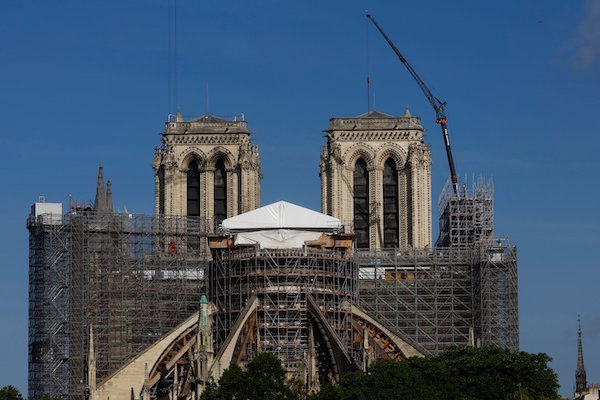
By Agnès Poirer
VAL DE BRIEY, France (OSV News) — Four years after a devastating fire, the date of the reopening of Notre Dame Cathedral in Paris has been set for Dec. 8, 2024, at 11:15 a.m., according to Philippe Villeneuve, the architect leading the reconstruction.
Villeneuve made the announcement March 16 during a trip to Val de Briey in eastern France, a small agricultural town near the Luxembourg border. It was there that the base of the famous Notre Dame spire was being assembled before its installation on the four pillars at the crossing of the cathedral’s transept, at a height of nearly 100 feet. The spire was destroyed when a fire ravaged the cathedral April 15, 2019.
Making the announcement with Villeneuve was Jean-Louis Georgelin, the five-star general appointed by French President Emmanuel Macron to oversee the operations of what French media have named “the building site of the century.”
“Let’s say 11.30 a.m. We may be slightly late,” the general joked in front of journalists.
Even if Paris’ famous medieval cathedral won’t reopen in time for the Paris Olympic Games scheduled for July 26-Aug. 11, 2024, the reopening date is a significant one for Catholics, as Dec. 8 marks the Solemnity of the Immaculate Conception, one of the biggest feast days of Mary, to whom French King Louis XIII consecrated himself, his dynasty and his kingdom in 1638.
In what Louis XIII called his vow, he had proclaimed: “We hereby declare that by taking the very saintly and very glorious Virgin as special protector of our Kingdom, we particularly dedicate to Her our person, our state, our crown and our subjects.”
At that time, the king stated that he desired a new altar for the cathedral — one with a depiction of the Pieta — Mary holding her son after he was taken down from the cross. The sculpture, created by brothers Nicolas and Guillaume Coustou, was commissioned by King Louis XIII’s son, Louis XIV, and it emerged completely intact from the 2019 fire. In fact, the spire and the vaults underneath it collapsed at its feet.
The fire, which started in the afternoon, quickly spread to the roof of the cathedral. The original 13th-century oak beams burned down. While firemen protected the stained-glass windows and the famous twin towers from catching fire, crowds gathered in shock around the cathedral and witnessed the collapse of the spire. Groups of the faithful were praying along the streets of Paris that their beloved cathedral would be saved.
Many treasures were, in fact, saved from the inside of Notre Dame, including the Crown of Thorns that is believed to be worn by Jesus during his passion. The crown temporarily is on display at the Louvre Museum.
Also present at the news conference were two dozen carpenters dressed in black, each with their tools hanging from a large leather belt, who have the responsibility of rebuilding Notre Dame’s roof and spire.
These men and women are considered the best in their trade — called “companions of duty,” in France. They started their apprenticeship at age 15 with a three-year Tour de France — and not on bicycles. According to artisanal traditions, these chosen carpenters tour the country, going town to town to learn skills from different master artisans.
The skilled companions are taught not only a craft but an ethic. Their motto is, “Neither self-serving nor submissive, but being of service.”
“It is the chance of a lifetime,” Paul Poulet, a 27-year-old carpenter who specializes in the restoration of historical monuments, told journalists March 16. Poulet works for Cruard Charpente, one of the four family-owned artisan companies chosen for the task.
Along with three other small companies based in different regions of France — Le Bras Frères, Asselin and MdB Métiers du bois — Cruard Charpente has chosen to set up its Notre Dame workshop in the leafy valley of Val de Briey.
The first assemblage of the “tabouret” of the spire — the base — is a crucial step. It will allow the workers to check if the 110 different pieces of oak used to make the base fit perfectly together. If not, they will recut a new piece from one of the 1,000 oak trees chosen last year in France’s former royal forests for the rebuilding of the 860-year-old cathedral.
The sheer scale of the carpenters’ workshop in Val de Briey is unprecedented. The spire base itself is 49 feet long, 43 feet wide and 20 feet high — and it is only one of the five pieces making the entire spire, which is high and will reach, once completed, 315 feet into the sky of Paris.
In early April, Poulet will travel with his fellow carpenters to the French capital to begin to raise the spire above the cathedral’s vaults. He is hoping for fair weather and as little wind as possible.
“At this height, things can get tricky, and the higher we go, the trickier it will be,” he said.
However, it is already known that it won’t be a carpenter giving the final touch to the spire on completion day. It will be Villeneuve, the architect-in-chief.
When the spire crashed down just before 8 p.m. on April 15, 2019, the copper rooster perched at its tip was feared lost. However, on April 16 at dawn, Villeneuve found the battered rooster lying in the gutter of Rue du Cloître-Notre-Dame, a street right next to the cathedral square.The relics of Paris’s patron, St. Genevieve, were found intact inside.
“Philippe Villeneuve will be the man who will place the copper rooster back at its place,” Georgelin confirmed.
